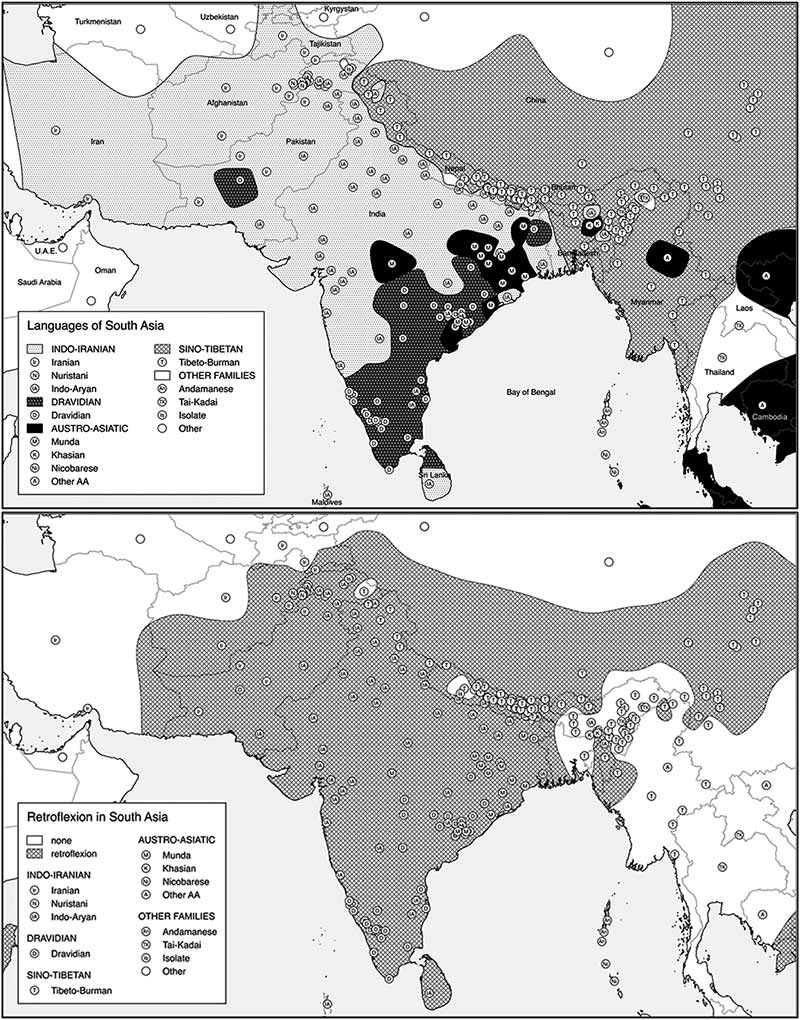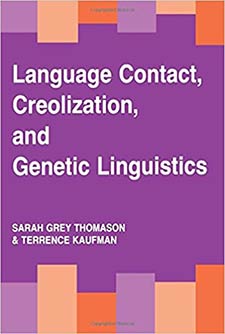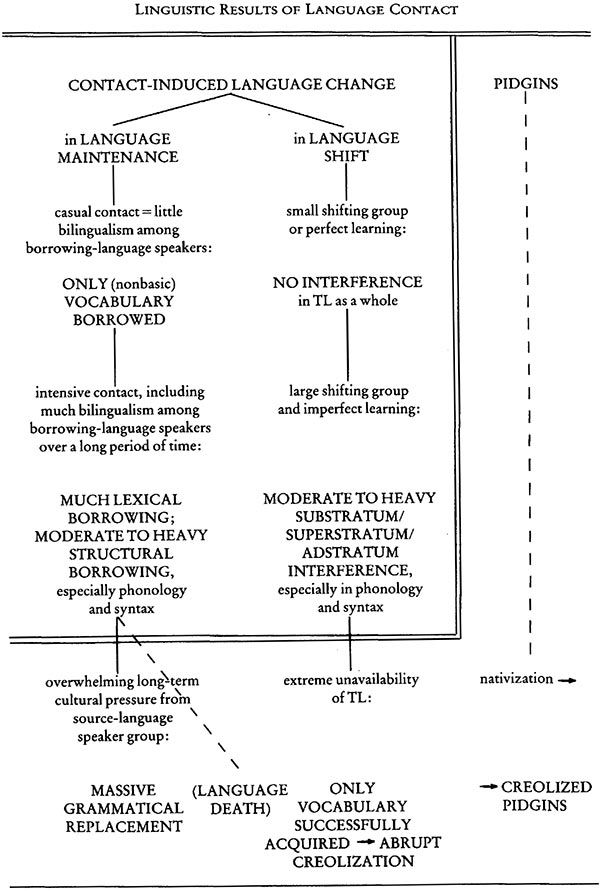The standard textbook for studying language contact, as far as I know, was Language Contact, Creolization, and Genetic Linguistics, by Sarah Grey Thomason & Terrence Kaufman, UCP (1991, c1988). The reader will surely recognize many of this text’s proposals of language contacts in my books.
Posts of the Language Contact series (reverse chronology):
- Proto-Hungarian Homeland: East and West of the Urals?
- Tug of war between Balto-Slavic and West Uralic (II)
- Early Uralic – Indo-European contacts within Europe
- Intense but irregular NWIE and Indo-Iranian contacts show Uralic disintegrated in the West
- Samoyedic shows Yeniseic substrate; both influenced Tocharian
- Pre-Germanic and Pre-Balto-Finnic shared vocabulary from Pitted Ware seal hunters
- Balto-Slavic accentual mobility: an innovation in contact with Balto-Finnic
- Pre-Germanic born out of a Proto-Finnic substrate in Scandinavia
Here are some relevant excerpts from the Introduction/Summary of chapter 1 (emphasis mine, some stylistic changes for clarity):
The starting point for our theory of linguistic interference is this: it is the sociolinguistic history of the speakers, and not the structure of their language, that is the primary determinant of the linguistic outcome of language contact. Purely linguistic considerations are relevant but strictly secondary overall. (…) Both the direction of interference and the extent of interference are socially determined; so, to a considerable degree, are the kinds of features transferred from one language to another.
Borrowing Vs. Interference through Shift
Borrowing
Borrowing is the incorporation of foreign features into a group’s native language by speakers of that language: the native language is maintained but is changed by the addition of the incorporated features. Invariably, in a borrowing situation the first foreign elements to enter the borrowing language are words. Typically, though not always, the borrowed words are treated as stems in the borrowing language that is, they take the usual affixes for the appropriate stem-class. (…) If there is strong long-term cultural pressure from source-language speakers on the borrowing language speaker group, then structural features may be borrowed as well phonological, phonetic, and syntactic elements, and even (though more rarely) features of the inflectional morphology. Although lexical borrowing frequently takes place without widespread bilingualism, extensive structural borrowing, as has often been pointed out, apparently requires extensive (though not universal) bilingualism among borrowing-language speakers over a considerable period of time.
Deshpande, for instance, points out that Southeast Asian languages have undergone no structural interference from Indic in spite of the fact that their speakers have adopted hundreds of Indic loanwords along with Hindu and Buddhist religious systems and a living tradition of Pali* texts. Even the characteristic retroflex Indic consonants in the loanwords are simply replaced by (and merged with) non-retroflex apicals, e.g., Indic t, ṭ, t and Indix n, ṇ, n in Old Cambodian and Old Siamese (Deshpande 1979:258). Since the speakers of Old Cambodian and Old Siamese were apparently not bilingual in the relevant Indic languages, this lack of phonological interference is predictable. Similarly, monolingual English-speaking British citizens living in India during the days of British rule adopted many Indian words for local items, but they apparently did not pronounce the words with retroflex or other non-English sounds. By contrast, once they had learned Russian the Soviet Asiatic Eskimos did borrow Russian sounds along with Russian words (…).
Incorporation of phonological features that enter the borrowing language with loanwords may seem the first and most obvious kind of structural borrowing to be expected in such cases as the Japanese and Eskimo ones. But all the evidence we have gathered indicates that structural (as opposed to merely lexical) interference is not so compartmentalized, at least in cases of moderate to heavy borrowing. In such cases, where there is phonological interference, there will be a comparable degree of syntactic interference too. Morphological interference lags behind these somewhat, but not as much as many authors have assumed (…). Even in cases of minor phonological interference, it may well be that minor syntactic interference is to be expected: if a person knows a second language well enough to incorporate some of its phonemes, s/he probably knows it well enough to incorporate some of its syntax as well.

Intereference
Substratum interference is a subtype of interference that results from imperfect group learning during a process of language shift.
That is, in this kind of interference a group of speakers shifting to a target language fails to learn the target language (TL) perfectly. The errors made by members of the shifting group in speaking the TL then spread to the TL as a whole when they are imitated by original speakers of that language. Of course, we do not mean to imply that imperfect learning has anything to do with lack of ability to learn; attitudinal factors may often be the crucial determinant for the shifting speakers’ version of the TL, and in other cases the main factor is availability of the TL. So “errors” are identified solely from the viewpoint of preexisting TL structure.
(…) unlike borrowing, interference through imperfect learning does not begin with vocabulary: it begins instead with sounds and syntax, and sometimes includes morphology as well before words from the shifting group’s original language appear in the TL. Often, in fact, the TL adopts few words from the shifting speakers’ language. This makes sense if one thinks about it a bit. If the speakers’ goal is to give up their native language and speak some other language instead, vocabulary is the first part of the TL they will need, so it is the first part they will learn. (Hoenigswald [1971:479] makes this same point.) They will probably keep their own native-language words only for things the TL has no words for: foods and other cultural items, and (if the TL speakers are invaders from elsewhere) names for local animals, plants, and so forth. Attitudinal factors may interfere with this prediction, but for substrata, at least in light to moderate interference, we expect the prediction to hold.
For instance, to take India as an example again, Emeneau’s hypothesis about the origin of retroflexion and other Dravidian features in Sanskrit and later Indic languages clearly involves substratum interference. This is evident in his remark that “absorption, not displacement, is the chief mechanism in radical language changes of the kind we are considering” (1964:644). If we interpret his proposal in the present context, the two basic assumptions are that Dravidian speakers, shifting in considerable numbers to the language of the Indo-Aryan invaders, imposed their own habits of (among other things) retroflex-vs.-dental articulation on Indic as they learned it; and that they were numerous enough to influence Indic as a whole, through the eventual imitation of their flawed Indic by original Indic speakers. This interference in Indic from Dravidian is striking in view of the fact that, as has frequently been observed, there are few old Dravidian loanwords in Indic. In sharp contrast, Sanskrit influence on some literary Dravidian languages has come about through borrowing native speakers of Dravidian languages are the initiators of the structural changes and accordingly we expect, and indeed find, large numbers of Sanskrit loanwords in Dravidian.
“Prestige”
A social factor that is frequently invoked in discussions of language contact is prestige. Moravcsik (1978:109) puts forward the hypothesis that “nothing can be borrowed (…) from a language which is not regarded [as] prestigious by speakers of the borrowing language.” She concedes that there is a convincing counterexample in the literature (in Nadkarni 1975, on interference from Kannada * in Konkani), but believes that the constraint is “otherwise plausible.” (…) To some extent this widespread view is supported by common sense: why would you replace some of your native lexicon and grammatical features with those of another language unless you wanted to emulate the speakers of that language because of admiration or respect for them? But common sense is an unreliable guide in historical linguistics, and the fallacy in this view has been recognized for decades at least since the following statement by Jakobson in his influential 1938 paper on phonological Sprachbund phenomena:
Contrairement à l’opinion courante l’action qu’une langue exerce sur la structure phonologique d’une autre langue ne suppose pas nécessairement la prépondérance politique, sociale ou culturelle de la nation parlant la première langue. Jakobson 1962 [1938]:2416
This assertion is as true for other parts of the grammar as it is for phonology. The most obvious flaw in the prestige claim is that it can hardly be true for cases of interference through shift when the shifting group is a true substratum (rather than an adstratum or superstratum). In such cases the dominance relationship is clear, and the interference features are sure to be nonprestigious, if not definitely stigmatized. Moreover, prestige often seems to be irrelevant in cases of borrowing as well. (…)
No clear-cut distinction
Now that we have carefully distinguished the two basic mechanisms of contact-induced language change, we must emphasize that there is unfortunately no reason to expect these two types of interference to take place in mutually exclusive contexts. Sometimes, to be sure, we find one without the other. Indic speakers did not, apparently, borrow much from Dravidian while shifting Dravidian speakers were changing their version of the Indic target language. Similarly, in many cases of borrowing we find no interference through shift to the borrowing language.
Special cases
Intensity of contact is not the same for shift and maintenance situations. In cases of language shift, where the shifting group is very small relative to the TL speaker group, there will be little or no interference in a TL as a whole (as opposed to an isolated subgroup like Indian English or Irish English speakers). In such cases the shifting speakers, in the absence of attitudinal barriers, will most likely have ready access to the TL as spoken by its native speakers; and even if the learners produce errors, the occurrence of the errors will not be so pervasive that original TL speakers acquire them. Exceptions might be expected (and have been claimed) in cases of superstratum interference, but we have found no convincing examples of extensive structural interference in such cases.
There will also be little or no interference, probably, if the shift occurs after the shifting group has become fully bilingual and well integrated into the TL speech community, because then the learning of the TL is likely to be perfect, not imperfect. However, possible situations of this type are difficult to interpret historically, because (as mentioned above) long-term shift situations, especially those with mutual bilingualism, are likely also to involve at least lexical borrowing by TL speakers from the shifting group’s language not just interference initiated by the shifting speakers. But if shift occurs rapidly, and if the shifting group is so large numerically that the TL model is not fully available to all its members, then imperfect learning is a probability, and the learners’ errors are more likely to spread throughout the TL speech community.
Intensity of contact in a borrowing situation crucially involves factors of time and of level of bilingualism. If few speakers of the borrowing language are bilingual in the potential source language, then normally only words will be borrowed. However, if there is extensive bilingualism on the part of borrowing-language speakers, and if this bilingualism persists over a long period of time, then substantial structural borrowing is a probability. Extensive bilingualism does not, however, imply that virtually every borrowing language speaker is bilingual.
Universally marked linguistic features
In general, because they are harder to learn, universally marked features are less likely than unmarked features to be transferred in language contact, including pidgin genesis. In shift situations, this works two ways: [1] shifting speakers are likely to fail to acquire marked features of the TL, and [2] marked features carried over by shifting speakers from their original language are relatively unlikely to spread by imitation to the TL as a whole. Both of these tendencies may result in a [a] decrease in the overall markedness of a (sub)system, and the frequency of such effects probably accounts for the commonly held view that substratum interference is largely simplificatory. But (…) some interference through shift results in [b] grammar complication – an increase in markedness. This probably occurs only in cases of moderate to heavy interference, and it may always begin with the carryover of contrasts and patterns from the shifters’ original language into their version of the TL that is, with their failure to learn that these patterns do not exist in the TL.(…)
The morphology presents a somewhat different problem. Since inflectional systems, in particular, tend to be highly structured and thus relatively closed, the integration of borrowed features into such systems may be difficult. We therefore find more cases of syntactic borrowing to replace a functionally congruent morphological feature than the reverse. We would agree with the general view that an elaborate inflectional morphology is (usually) more highly marked than corresponding syntactic structures, so in this domain markedness is a significant factor in borrowing, as it is in interference through shift.
Typological distance
Unlike markedness, typological distance seems to be as important for borrowing as it is for interference through shift. (…) Weinreich (1953) emphasizes the importance of functional congruence in facilitating morphological interference in particular. Similarly, Vildomec observes that “it is really not the linguistic difference between two languages that fosters mutual interference, but, on the contrary, the similarity” (1971:78). (…)
(…) although we have no definitive evidence to support it, our tentative hypothesis is that in cases of light to moderate structural interference, the transferred features are more likely to be those that fit well typologically with corresponding features in the recipient language. That is, we believe (with Meillet, Weinreich, Vildomec, and others) that one structure will more readily replace another if they already match rather closely in function.
In phonology, interference in these cases very often results in the phonemicization of previously nondistinctive phones.
Examples are the phonemicization of [v z] in Middle English, which was caused at least in part by French influence (…); and, if those who argue for previously existing phonetic retroflexion in Indic are correct, the development of phonemic retroflexion in Indic, under Dravidian influence. Of course, entirely new phones and phoneme types also appear as interference features, but if our hypothesis is correct these will be rarer in light to moderate interference than the innovations that fit better with the receiving language’s preexisting phonetics and phonology.
In morphology and syntax it seems likely that most interference, except in cases of heavy influence, will involve either new means of expressing functional categories already present in the receiving language or (for morphology) loss of previously existing categories (…). Syntactic examples that fit the pattern vary considerably, but they may be most prevalent in word order changes. (…)
Why is an external explanation appropriate
(…) historical linguists have traditionally been strongly prejudiced in favor of internal explanations for linguistic changes. In particular, the methodological inclination has been to consider the possibility of external causation only when all efforts to find an internal motivation for some change have failed (see, e.g., Martinet 1955:194, Polomé 1980:196). Aside from the fact that a weak internal motivation is less convincing as a cause than a strong external motivation, the possibility of multiple causation should be kept in mind. (…) It may well be that, as some have argued, phonemic retroflexion in Indic arose in a series of phonetically plausible stages, but the original stimulus or trigger for that series of changes was surely the Dravidian substratum influence. In other words, even if Vogt were correct in believing that structural changes can always be described “in terms of the system in which they take place” (1954:372373), it would not follow that the best explanations for them will always be achieved through such descriptions.
Similarly, interference through shift in particular may even be responsible sometimes for lack of change. This means that, since retention as well as innovation may be externally motivated, the presence of inherited features is not always adequately explained once one determines their genetic origin.
For example, the elaborate systems of noun inflection in most Balto-Slavic languages resemble reconstructed proto-Indo-European noun inflection (or, at least, one common reconstruction which rests heavily on the evidence of Indo-Iranian) in a number of striking ways. The possibility should at least be considered that the Balto-Slavic case systems were retained under the conserving influence of a Uralic substratum, because the relevant Uralic languages have some of the most elaborate case systems in the world (…)
Featured image: Этнографическая Карта Российской Империи, from Wikipedia
Related
- Early Uralic – Indo-European contacts within Europe
- Intense but irregular NWIE and Indo-Iranian contacts show Uralic disintegrated in the West
- Samoyedic shows Yeniseic substrate; both influenced Tocharian
- Pre-Germanic and Pre-Balto-Finnic shared vocabulary from Pitted Ware seal hunters
- Balto-Slavic accentual mobility: an innovation in contact with Balto-Finnic
- Pre-Germanic born out of a Proto-Finnic substrate in Scandinavia
- Corded Ware—Uralic (II): Finno-Permic and the expansion of N-L392/Siberian ancestry
- The traditional multilingualism of Siberian populations

